================================================================================
 (100*100*4,) 1D array is needed for 100x100 maze problem using Q table learning
- 4: actions (LRUD)
================================================================================
$$$2^{80\times 80}$$$: number of possible screen of right situation
Creating $$$(2^{80\times 80},)$$$ 1D array is impossible
================================================================================
Q methodology is good but you can't use Q table for practical problem
================================================================================
(100*100*4,) 1D array is needed for 100x100 maze problem using Q table learning
- 4: actions (LRUD)
================================================================================
$$$2^{80\times 80}$$$: number of possible screen of right situation
Creating $$$(2^{80\times 80},)$$$ 1D array is impossible
================================================================================
Q methodology is good but you can't use Q table for practical problem
================================================================================
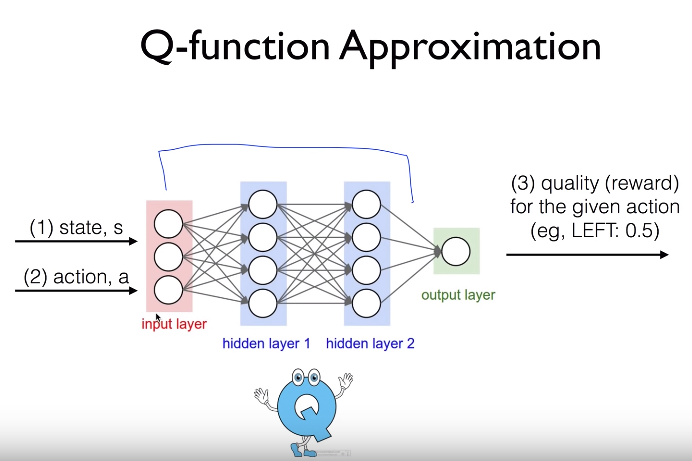 - Network: takes input, release output
- State s and action a can be considered as input
- Output from output layer can be considered as Q value of Q mentor
- Idea: let's use Q-network instead of Q-table
================================================================================
- Network: takes input, release output
- State s and action a can be considered as input
- Output from output layer can be considered as Q value of Q mentor
- Idea: let's use Q-network instead of Q-table
================================================================================
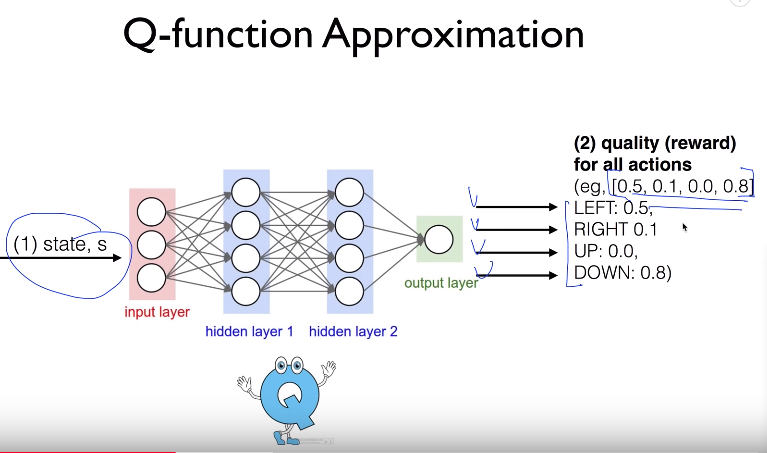 - You can variant version of Q-network
- Q-network takes state s as input
- Q-network outputs 4 length 1D array like [0.5,0.1,0.0,0.8]
[0.5,0.1,0.0,0.8] can be considered as Q values to left, right, up, down
================================================================================
- You can variant version of Q-network
- Q-network takes state s as input
- Q-network outputs 4 length 1D array like [0.5,0.1,0.0,0.8]
[0.5,0.1,0.0,0.8] can be considered as Q values to left, right, up, down
================================================================================
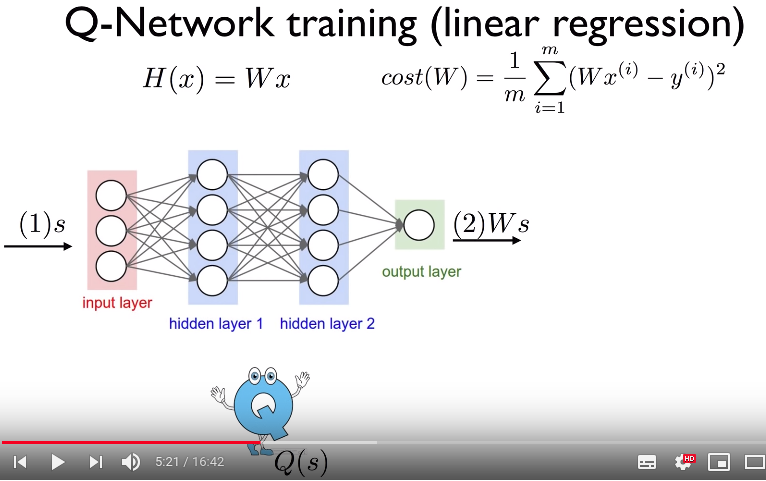 - Let's train Q-network as linear regression problem
- You training goal is to make Ws become optimal $$$Q$$$ value $$$Q^{*}$$$
- Optimal $$$Q$$$ value $$$Q^{*}$$$ can be considered as label
================================================================================
Model funcion: H(x)=Wx
- x: input
- W: trainable parameter
================================================================================
Cost function: $$$\text{cost}(W)=\dfrac{1}{m} \sum\limits_{i=1}^{m} (Wx^{(i)} - y^{(i)})^2$$$
$$$Wx^{(i)}$$$: prediction
$$$y^{(i)}$$$: label
================================================================================
- Let's train Q-network as linear regression problem
- You training goal is to make Ws become optimal $$$Q$$$ value $$$Q^{*}$$$
- Optimal $$$Q$$$ value $$$Q^{*}$$$ can be considered as label
================================================================================
Model funcion: H(x)=Wx
- x: input
- W: trainable parameter
================================================================================
Cost function: $$$\text{cost}(W)=\dfrac{1}{m} \sum\limits_{i=1}^{m} (Wx^{(i)} - y^{(i)})^2$$$
$$$Wx^{(i)}$$$: prediction
$$$y^{(i)}$$$: label
================================================================================
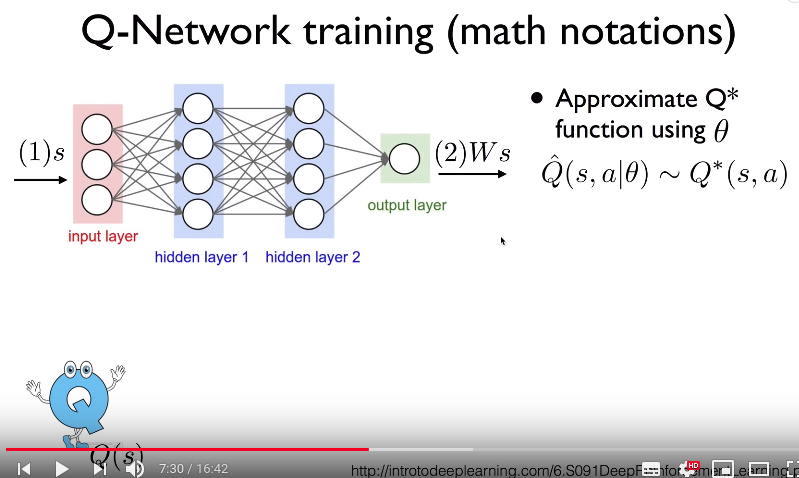 - You will replace Ws with $$$\hat{Q}(s,a,|\theta)$$$
-$$$\hat{Q}(s,a,|\theta)$$$: Q is function wrt state s and action a
but varying $$$\theta$$$ affect Q and s and a
- $$$\theta$$$: trainable parameters in Q-network
- Your goal: $$$\hat{Q}$$$ should much approximate optimal $$$Q^{*}$$$
$$$\hat{Q}(s,a|\theta) \sim Q^{*}(s,a)$$$
================================================================================
How can you make $$$\hat{Q}$$$ much approximate optimal $$$Q^{*}$$$?
$$$\min_{\theta} \sum\limits_{t=0}^{T} [ \hat{Q}(s_t,a_t|\theta) - (r_t+\gamma \max_{a^{'}} \hat{Q}(s_{t+1},a^{'}|\theta))]^2$$$
- Minimize difference
- By adjusting trainable parameters $$$\theta$$$
================================================================================
- You will replace Ws with $$$\hat{Q}(s,a,|\theta)$$$
-$$$\hat{Q}(s,a,|\theta)$$$: Q is function wrt state s and action a
but varying $$$\theta$$$ affect Q and s and a
- $$$\theta$$$: trainable parameters in Q-network
- Your goal: $$$\hat{Q}$$$ should much approximate optimal $$$Q^{*}$$$
$$$\hat{Q}(s,a|\theta) \sim Q^{*}(s,a)$$$
================================================================================
How can you make $$$\hat{Q}$$$ much approximate optimal $$$Q^{*}$$$?
$$$\min_{\theta} \sum\limits_{t=0}^{T} [ \hat{Q}(s_t,a_t|\theta) - (r_t+\gamma \max_{a^{'}} \hat{Q}(s_{t+1},a^{'}|\theta))]^2$$$
- Minimize difference
- By adjusting trainable parameters $$$\theta$$$
================================================================================
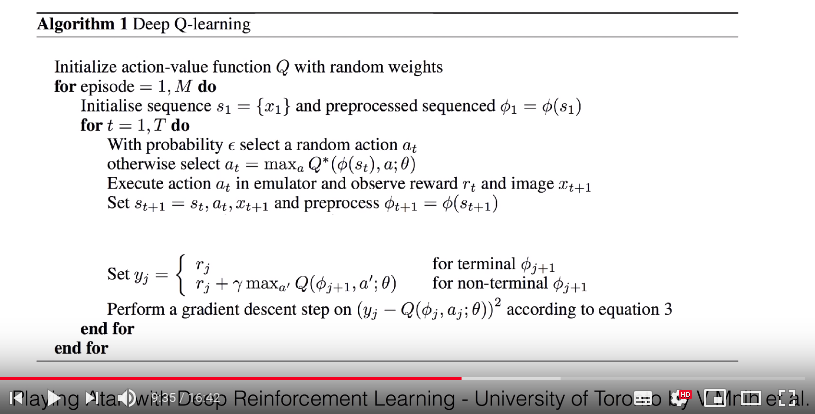 - Initialize...: Randomly initialize trainable parameters in Q-network
- Initialise sequence...: create first state $$$s_1$$$
- and preprocessed...: Preprocess state (for example, process image, etc) by using function $$$\phi$$$
- With probability...: exploration using e-greedy to select action $$$a_t$$$
- otherwise select...: expoit
- Execute action...: execute action $$$a_t$$$ and get reward and state (like image $$$x_{t+1}$$$)
- Set $$$y_{j}$$$...: training part
================================================================================
- Initialize...: Randomly initialize trainable parameters in Q-network
- Initialise sequence...: create first state $$$s_1$$$
- and preprocessed...: Preprocess state (for example, process image, etc) by using function $$$\phi$$$
- With probability...: exploration using e-greedy to select action $$$a_t$$$
- otherwise select...: expoit
- Execute action...: execute action $$$a_t$$$ and get reward and state (like image $$$x_{t+1}$$$)
- Set $$$y_{j}$$$...: training part
================================================================================
 * $$$y_{j}$$$: label
* $$$(y_j - Q(\phi_j,a_j;\theta))$$$: loss function
* $$$r_j$$$: reward agent gets at terminal place
* $$$r_j + \gamma \max_{a^{'}} Q(\phi_{j+1},a^{'};\theta)$$$: reward agent gets at non-terminal place
* $$$(y_j - Q(\phi_j,a_j;\theta))^2$$$.backward()
* ADAM_optimizer.step()
================================================================================
* $$$y_{j}$$$: label
* $$$(y_j - Q(\phi_j,a_j;\theta))$$$: loss function
* $$$r_j$$$: reward agent gets at terminal place
* $$$r_j + \gamma \max_{a^{'}} Q(\phi_{j+1},a^{'};\theta)$$$: reward agent gets at non-terminal place
* $$$(y_j - Q(\phi_j,a_j;\theta))^2$$$.backward()
* ADAM_optimizer.step()
================================================================================
 Q-network under deterministic and non-deterministic environment
* In neural net, you don't use $$$(1-\alpha)Q(s,a) + \alpha [ r+ \gamma \max_{a^{'}} Q(s^{'},a^{'})]$$$ as target $$$y_j$$$
even if env is non-deterministic.
* As you can see, you use $$$r_j + \gamma \max_{a^{'}} Q(\phi_{j+1},a^{'};\theta)]$$$ as target $$$y_j$$$
================================================================================
Will it work? It works because neural network trains "gradually"
================================================================================
Q-network under deterministic and non-deterministic environment
* In neural net, you don't use $$$(1-\alpha)Q(s,a) + \alpha [ r+ \gamma \max_{a^{'}} Q(s^{'},a^{'})]$$$ as target $$$y_j$$$
even if env is non-deterministic.
* As you can see, you use $$$r_j + \gamma \max_{a^{'}} Q(\phi_{j+1},a^{'};\theta)]$$$ as target $$$y_j$$$
================================================================================
Will it work? It works because neural network trains "gradually"
================================================================================
 * If you minimize difference of pred_Q-target_Q by adjusting $$$\theta$$$
prediction $$$\hat{Q}$$$ converges to $$$Q^{*}$$$?
* In neural network, it diverges due to
(1) correlations between samples
(2) non-stationary targets
================================================================================
Above Q-network issue had been solved by DQN algorithm by DeepMind
================================================================================
DQN
(1) deep networks
(2) experience replay
(3) separated networks
* If you minimize difference of pred_Q-target_Q by adjusting $$$\theta$$$
prediction $$$\hat{Q}$$$ converges to $$$Q^{*}$$$?
* In neural network, it diverges due to
(1) correlations between samples
(2) non-stationary targets
================================================================================
Above Q-network issue had been solved by DQN algorithm by DeepMind
================================================================================
DQN
(1) deep networks
(2) experience replay
(3) separated networks








